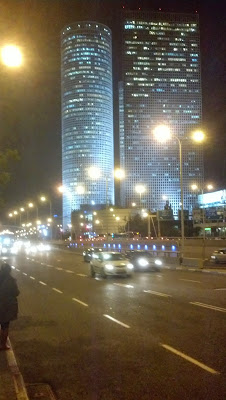Day 3 of
sightseeing in Israel
The
following day, I took a Sherut back to Jerusalem. Sheruts are 10 passenger vans like the
shuttle vans used at airports to take you to your rental car. They depart from the Central Bus Station in
Tel Aviv and travel to various cities throughout Israel. To go to Jerusalem, the cost is about $7.00. Unlike busses or trains, they don’t run on a
set timetable. Instead they leave when
there are 10 passengers on board, and then make a speedy trip to their
destination. The cost is the same as a
bus but without the stops along your route.
They fill up almost immediately from Tel Aviv to Jerusalem, whereas the
return trip may take 15 to 20 minutes before they are full and depart.
Once in Jerusalem, I took a taxi to the
Israeli Museum with a stop in front of the Knesset for a couple of photos. This could have been another all day visit to
a museum, but since I wanted to also go back to the Old City, I made a hurried
trip through most of it with the intention of seeing the Dead Sea Scrolls.
Like the Holocaust Museum, no
photographs were allowed inside the depository for the Dead Sea Scrolls. The
depository is in the shape of the tops of the clay urns the Scrolls were found in. It is amazing they went all those centuries
undiscovered! Equally amazing is, after
they were discovered and sold to various collectors around the world, they were
recovered and are now housed in Jerusalem.
Some of the Scrolls look like burned or scorched pieces of paper while
others are in perfect condition.
The urn shaped museum
the Dead Sea Scrolls are located in with the flat roofed Knesset in the
background

Beside the
Dead Sea Scrolls repository is a 1:50 scale miniature of what Jerusalem looked
like during the late 2nd temple period from descriptions in 70 AD. The buildings of significance are recognized
on plaques around the outside of it as well as the Via Dolorosa.
The Jewish 2nd Temple is in the foreground. It was destroyed by the Romans and the Muslim
Dome of the Rock replaced it approximately 600 years later
Another view of the Walled City of Jerusalem in 70 AD
During my
stay in Tel Aviv, I spent each evening along the beach. Many nice restaurants are located there to eat
either inside the restaurant or at tables outside to enjoy the sunsets. My first night at the Embassy Hotel, which I
noticed was a very quiet and relaxing place, was interrupted by chanting. Being right across the street from the U.S.
Embassy, I discovered a protest against Obama’s plan to fire missiles into
Syria. All available gas masks in Israel
had been purchased should missiles containing poisonous gas be fired from Syria
into Israel. The country of Israel is on
alert at all times, surrounded by countries who want to destroy it. The Jewish
protesters were not interested in having an outsider start a war right on their
northeastern border with an enemy who would retaliate against them also.
My return home trip was like the rest
of the time on this well. No definite
end to my trip! Because of the rainy
weather on the eastern U.S. coast, like the floods in Colorado, our United
Airlines jet was delayed leaving Newark, New Jersey and getting to Israel. This caused a delayed departure from Tel Aviv
to Newark. The weather there had delayed and cancelled many flights all day so I
got to spend a rainy night in Newark in a hotel. The rain prevented viewing the Statue of
Liberty in New York harbor or the Empire State Building and the new 1 World Trade
Center in Manhattan. Even the flight the
next morning was hazy, and I departed while
it was still dark, so unlike the other flights into and out of Newark, I was
unable to catch a glimpse of these landmarks.
I arrived in Colorado late morning after
all the rain and flooding. Thankfully, none
of my family was affected by this terrible disaster.
While in Israel, I heard rumors of
another well being drilled offshore, possibly next year. If this occurs, and I am lucky enough to be
involved, I will continue this blog at that time.











